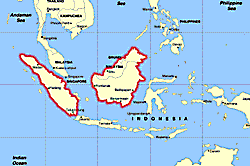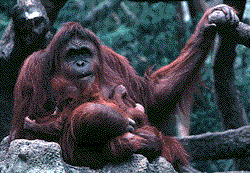![]()
To know what, how, when, and where to eat in the tropical rainforest takes brains. Investigating and demonstrating the intelligence of orangutans, less studied than the more demonstrative chimpanzees, is one of the objectives of the National Zoo's Think Tank exhibit, which opened in 1995. Orangutans there participate in a variety of behavioral events for the edification of visitors, for example, using bamboo rods or twigs to drag treats, such as cereal or dried apricots, through openings the apes cannot reach through. Some of the events are more experimental, involving staff setting up a situation (such as a keeper losing keys in view of the orangutan) to investigate whether orangs are aware of the thought processes of people and can analyze or empathize with them. There is also an Orangutan's Language Project that uses flashcards to teach the ape-participants abstract symbols and their assigned meanings; the orangutans indicate recognition by tapping the right keys on a computer keyboard. The orangs volunteer to participate in these activities by traveling the 500 feet from their quarters in the Great Ape House to the Think Tank on overhead cables strung between eight 45-feet towers, 35 feet above visitors watching on the ground. The Think Tank also has interactive games and other displays about human and other animal cognition, a colony of tropical leaf-cutter ants (to contrast complex, innate behavior), and a troop of Sulawesi macaques (to demonstrate complex social behavior). -CG |

| Although orangutans once ranged throughout southeast Asia and into China, today they are found only on the Indonesian islands of Borneo and Sumatra. The Sumatran subspecies (Pongo pygmaeus abelii) is taller and more slender than the Bornean subspecies (Pongo pygmaeus pygmaeus); Bornean males usually have larger forward-curving flaps on their faces, while Sumatran males usually have a long goatee. The influx of the South China Sea geographically isolated the two subspecies from each another one million years ago. Genetic analysis of both captive and wild individuals has demonstrated that the Bornean form differs significantly from the Sumatran form, perhaps as much as the chimpanzee (Pan troglodytes) differs from the bonobo (Pan paniscus), which are considered different species. -CG |
![]()
by Cindy Gray
In sunlight, an orangutan's burnt-orange fur catches the light and blazes as though on fire. But in the shadowy twilight beneath the rainforest canopy, its coat blends in, almost as if the great ape had disappeared. Orangutans are the quintessential rainforest inhabitant, the largest animal adapted to the challenges of exploiting the bounty hidden in the trees. So well suited are they to life in the humid jungles of Borneo and Sumatra that they appear out of place anywhere else.

The diversity of the rainforest is reflected in the variety of the fare orangutans consume. Researchers at the Tanjung Puting Reserve of Borneo have recorded wild orangs eating more than 400 different foods. Their diet is primarily fruit and young leaves, but also includes bark, wood pith, sap, flowers, honey, termites, shoots and stems, seeds, nuts, bamboo, and funguses. A list of the fruits they eat is striking: lychees, rambutans, taraps, lansats, wild plums, figs, durians, Merbou, sindar, Banitan, merang, kubriz, Neesia, and pintau. Orangs must be brilliant botanists to recognize which products of the approximately 750 tree species in a lowland Asian tropical rainforest are edible, nutritious, and nontoxic.
Orangutans also must be adept at processing foodstuffs to get at the edible portions that may be hidden beneath shells, burrs, or husks. Depending on the fruit species, an ape may have to drain syrupy goo from the skin, spit out inedible seeds, extract edible seeds from large prickly pods with its teeth and tongue, or crush hard nuts. For example, after the strong, unpleasant odor of the rind of the durian (a favored food item) has drawn an orang from as much as a half mile away, the animal must then struggle with a fruit weighing two and a half pounds and covered with spikes, until it manages to tear open the thick husk with its teeth and jaws to get at the sweet flesh. Orangutans have been observed fashioning and using tools to obtain food that otherwise would be inaccessible.
Almost completely arboreal, orangutans are built to exploit this cornucopia. Although they are too heavy to jump from branch to branch like smaller primates, their physical adaptations enable them to move through the canopy in a complex, three-dimensional manner. Their arms are almost twice as long as their legs, their hips and legs are as flexible as their shoulders and arms, both their hands and feet are long and hook like, and their big toes are more fully opposable than those of gorillas and chimps. An orangutan uses its long arms to swing from branch to branch and uses its weight to sway an entire tree close enough to stretch forward, sideways, diagonally, upward, and/or downward with one long arm to latch onto a branch from a neighboring tree before easing one arm or leg at a time across the gap. In a zoo habitat, an orangutan's slow movements may be misinterpreted as sluggishness or listlessness, but careful clambering is a locomotive adaptation to safely maneuvering a large body along a tangled, and sometimes rickety, aerial path of vines and trees.
Orangutans must move through the forest constantly to follow the shifting harvest of different cycles of flowering and fruiting. Due to the large number of species in the tropical rainforest, there are few trees of the same species, and they are not found in clusters or groves as in temperate forests, but are randomly scattered throughout the forest. To get enough sustenance, a wild orang must know where to find food without wasting energy on aimless or futile wandering. To ensure that it is in the right place at the right time, an orangutan seems to carry a detailed map of its home range in its memory that includes the location of food sources, the distance between them, when a particular tree is fruiting, which berries are ripe, and where termites are hatching.
An orangutan may spend an hour eating ripe fruit in a tree, leave that tree, and move deliberately and purposely to another tree of the same species that is also ready to be harvested. Along the way, it may examine the leaves and fruit of other trees, apparently to check the readiness of the crop. If the fruit is not yet ripe or the leaves are too mature (and therefore toxic), the orang seems to archive this information and returns later when the fruit is ripe or new, young leaves have developed.
Even orangutan social structure is an adaptation to the demands of supporting the world's largest arboreal creature on the scattered abundance of the rainforest. A young orangutan usually remains with its mother for about eight years, learning through observation of her finding and processing food to become an expert forager.
Moreover, given their large size, solitary foraging is usually the most efficient way for orangutans to obtain sufficient nourishment, as too little food is available at the same time and place to support the gregarious community or family groups in which many other primates live. In eight hours, a single orangutan may consume all the edible produce on one tree. If orangs fed in groups, they would have to travel more often and longer distances, find more sources of food, and, perhaps, compete for what they find.
Although orangutans are generally characterized as solitary, wild orangutan social structure is not simple, particularly given how seldom they interact. Orangs know the individuals in their area and have relationships that are very structured. Birute Galdikas, Ph.D., who has studied orangutans in Borneo since 1971, prefers to describe orangutans as semi-solitary or solitary but social. She sees the infrequent social interactions as evidence not that orangutans are great ape wallflowers, but that they have amazing social memories.
All orangutans go through a gregarious stage as they become independent from their mothers, seeking out playmates their own age for several years after weaning. Adolescent females often team up for days or even weeks. They apparently form friendships (and make enemies), and as adults seem to remember each other without hesitation after months, perhaps years, without contact. They are not very demonstrative; they generally do not embrace, groom one another, share food, or inspect each other's infants. Galdikas believes they communicate through vocalizations, facial expressions, gestures, postures, and movements, some of which may be too subtle for human observers, giving rise to the mistaken belief that orangutans are passive and aloof in each other's presence. Adult females may travel and rest together for several days and eat in the same tree without fighting.
Because they do not live constantly in groups and, therefore, do not need each other, Galdikas reasons, orangutans do not need to endlessly test and reaffirm their relationships or manipulate one another as some primate species-chimpanzees, gorillas, and humans-do. She compares female orangutan companions to old friends who don't need to talk to enjoy being together.
Although males are even more solitary than females, the males in an area maintain a dominance hierarchy for years without interacting very often or even seeing one another. They do so by recognizing each other's long calls, forming a mental representation of the caller even in the absence of visual contact, and acting according to the other male's rank in the hierarchy. Galdikas contrasts that with male chimpanzees' vigorous physical displays (such as branch waving and charging) to establish and maintain rank, a difference she compares to that between playing football and playing chess in your head. When they do meet, if threats are not enough, male orangutans grab each other and grapple vigorously, frequently pushing each other to the forest floor and biting the shoulders, ears, and cheekpads of their opponent. Their fighting style may explain their heavy shape, which is similar to that of Japanese sumo wrestlers.
Orangutans are losing their homes in the trees as timber interests and farming take over their rainforest habitat. According to a 1993 survey by IUCN-World Conservation Union, suitable orangutan habitat has declined by more than 80% in the past 20 years. The total orangutan population dropped to between 10,000 and 16,000 in Borneo and between 7,000 and 12,000 in Sumatra, with many of the remaining orangs trapped in fragments of forest far too small to support the population. Fewer trees means less food and shelter for orangutans and makes them more accessible to poachers, who kill the mothers so the infants can be sold as pets. Having adapted to make a living for themselves, despite the exigencies of the treetops, the red apes are now dependent on humans to ensure that they continue to have a place in which to prosper.
Sources: Berghaier, Tanjung Puting. "Home of the Red Ape." Animal Keeper's Forum, November 1996.
Galdikas, Ph.D., Birute M. F. Reflections of Eden: My Years with the Orangutans of Borneo, 1995.
Getler, Warren. "How Smart Are They?" The Washingtonian, November 1995.
Kuznik, Steve. "How to Be an Orangutan," International Wildlife, January/February 1997.
MacKinnon, John. In Search of the Red Ape, 1974.
Perkins, Lori. "On Captive Orangutan Management." Pongo, Fall/Winter 1995.
